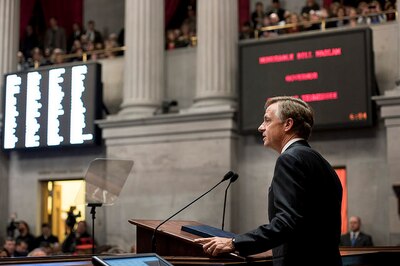Shelby County Mayor Mark Luttrell says it’s time to rethink the cost of K-12 education — in Memphis, and likely in Tennessee as well.
Fresh from reviewing the latest funding allocations to Shelby County Schools, Luttrell points out what the state is paying, what the county is obligated to pay, and what the county actually pays to operate the state’s largest public school district.

It’s the $52 million gap between what the county is obligated to pay and what the county actually pays that worries him, especially given the state’s stagnant allocations and the county’s increasing contributions, often to pay for state-mandated education reforms.
“We’re giving a lot of money to education that’s over and above — that we shouldn’t have to,” Luttrell said. “[That figure] also tells us that the state is not meeting their full contribution.”
Luttrell’s conclusion is one that’s being reached by more and more local government officials across Tennessee amid tension over perennial requests from local school leaders for more funding.
Historically, the local government receives notice of the state’s education allocation, as well as the local education obligation, under the state funding formula known as Basic Education Plan, or BEP. School district leaders then go before the local government funding bodies, typically asking for more local money to cover their increasing costs, and get grilled over their spending priorities, before the final funding amount — and local property tax rate — is set.
But increasingly, in the midst of often heated discussions between local government and school leaders, officials are looking up from their spreadsheets and wondering aloud whether the funding system they’re working under might be broken, or at the very least outdated.
“The argument used to be how we divied up the pie,” said Wesley Robertson, a budget and finance consultant for county governments across the state. “Now they’re saying the pie is not big enough.”
Breaking down the BEP
Created in 1992 in an attempt to provide a fair and equitable allocation of state education funding between urban and rural districts, the state’s BEP is designed to provide a basic level of education for all Tennessee students, no matter what their school district. The formula uses 45 ratios based on factors such as what a typical class size should be and how much an administrator should be paid.
The BEP was last updated in 2007 — five years before Tennessee launched sweeping education changes under the federal Race to the Top initiative. Critics charge that the formula now low-balls the cost of education, with allocations that have not kept pace with inflation, on-the-ground enrollment challenges, a growing charter school industry and new mandates to improve the state’s worst-performing schools — efforts that require extra staff and expensive intervention programs.
While Tennessee taxpayers spend around $6 billion a year on education — which should be split about 50-50 between state and local revenue — around $4 billion currently is being paid by local governments, according to a Chalkbeat analysis.
The additional local expense has evolved due to several factors — the bulk of which stems from a misalignment between what the state deems an average class size and the local realities of staffing schools. Fluctuating student populations often force officials to scramble at the last minute to avoid overcrowding, but BEP doesn’t factor in the need for extra teachers.
In addition, BEP formulates an annual teacher salary at $40,000, but the average teacher salary across the state last year was $50,000. In Shelby County, a first-year teacher makes $42,000, with the average salary at $60,000.
Meanwhile, a growing charter sector is siphoning off thousands of students from Shelby County Schools, which results in decreased BEP revenue for the district but not a decrease in fixed costs such as loan payments for buildings, utilities or administrators’ salaries.
In Shelby County, county government now contributes more than $391 million a year to education through Shelby County Schools and six suburban municipal school systems. That’s $52 million more than they’re obligated to pay under the BEP, according to a Chalkbeat analysis.
Against that funding reality, the Shelby County Commission signed off earlier this month on its 2015-16 spending plan — without a tax increase — after numerous budget hearings in which leaders of Shelby County Schools asked for $15 million more to pay for new student computers and additional literacy coaches, among other things. They got close to $8 million more, but not before commissioners questioned the district’s spending priorities and suggested where the extra money should go.
“We need to bring prudence to Shelby County Schools, as we do for Shelby County government,” budget committee chairwoman Heidi Shafer told school leaders during a two-hour hearing in May.
"What incentive does the state have to fully fund the BEP if we keep picking up their slack?"
David Reaves, Shelby County Commissioner
District leaders countered that they’re already there. The Shelby County Board of Education cut $125 million before approving a $1 billion budget this spring, laying off more than 500 employees, closing several schools and tapping into its savings account to stave off more cuts. During the last two years, the district has made $275 million in cuts.
District leaders complained to commissioners that they’re working off a spending plan that the state is woefully underfunding based on a formula that they say grossly underestimates the “true cost” of education. If the state paid its full obligation under the BEP, the district would receive an extra $100 million annually, according to board member Chris Caldwell.
“What incentive does the state have to fully fund the BEP if we keep picking up their slack?” asked commissioner David Reaves during one budget hearing in May. “We need to create a climate where there’s a burning need [for the state to fulfill its obligation].”
“If you want to get off the hot seat,” an exasperated Caldwell told commissioners, “you should go to the state and tell them to give us our due amount.”
Picking a battle
Shelby County isn’t an outlier. School leaders for all three of the state’s other largest districts—in Nashville, Knoxville and Chattanooga — asked their local funding bodies for additional money as well this spring.
The biggest request—for a 40-cent tax increase to generate an additional $34 million for schools—was hashed out in Chattanooga through Hamilton County Schools. Hamilton County Mayor Jim Coppinger rejected the proposal, forcing Superintendent Rick Smith to go back to the drawing board and reduce a proposed teacher pay increase from 5 to 2 percent.
Meanwhile, across the state, local governments are picking up $1 billion more than they’re obligated to under the state’s BEP formula, and district and local government leaders are increasingly shifting the focus of their frustrations to Nashville and the state Capitol, where the state distributes education funding based on the BEP.
“(Districts and local governments) can’t get anything done locally and they want to fight,” said Robertson, who represents county governments across the state. “Our message is, ‘You need to be on the same team. Come together and turn your attention toward the state.'”
In March, that’s exactly what boards for seven school districts in southeast Tennessee did. Led by the Hamilton County Board of Education in Chattanooga, the districts filed a lawsuit charging that the state has created a system that “shifts the cost of education to local boards of education, schools, teachers and students, resulting in substantially unequal educational opportunities across the State.” But unlike three prior lawsuits alleging built-in inequities in the formula, Hamilton’s lawsuit focuses on inadequacy and argues that the formula fails to “account for the true cost of educating students in Tennessee.”

The state is urging dismissal, arguing that the legislature has leeway in funding K-12 education. And Gov. Bill Haslam, who this year championed a $147 million increase in education spending across Tennessee to address BEP funding and increase teacher salaries, has repeatedly urged district leaders to engage the state in conversation instead of litigation.
“The reality is we’re making dramatic improvements in education,” Haslam said in April after lawmakers wrapped up their legislative session. “I challenge you to go around and look at any other state and see what they’re doing in terms of improving funding for education, and I’ll take Tennessee.”
Before recessing for the year, lawmakers considered a bill that would have required the state to fully fund the BEP, but the measure was tabled and never reached a committee vote. The bill is scheduled for discussion Thursday as a House education panel convenes its summer study session.
Shelby County school leaders aren’t waiting around for state lawmakers to act.
Shortly after passing its leaner budget, the district’s Board of Education voted to hire an attorney to explore suing the state over its level of funding. District leaders elsewhere in the state, including in Nashville and Knoxville, have explored similar action, though no additional lawsuits have been filed.
Caldwell has led the charge to take the state to court in Memphis, arguing that neither Haslam nor any individual legislator can guarantee anything to local school districts.
“We’re 45th in per-pupil spending in the country, and it’s beyond the time for empty promises. These kids don’t get these years back,” he said.
A looming new baseline
Luttrell is watching all of these moving parts with interest with the knowledge that Shelby County government is in a unique position to reset the cost of education in Memphis, despite whether the state eventually increases state education funding or tweaks the BEP further.
While Tennessee law prohibits reductions in local education funding from one year to the next, Shelby County government can choose to lower its contribution by 2017. That’s because state law allows an exception to local governments due to significant operational changes such as, in Shelby County’s case, the merger of the city and county school systems in 2013 and the break-off a year later of six suburban municipalities that created their own school systems.
Luttrell says he’ll be watching closely how Shelby County Schools Superintendent Dorsey Hopson manages his education budget and whether he makes more cuts, noting that the district operates dozens of under-enrolled schools. He’ll also be looking to see how the district reduces its worrisome liability for retiree benefits.
“We’ve got three years to ask the tough questions of education,” Luttrell said. “I’d like to be comfortable that we’ve done our due dilligence, and we collectively agree what should be our new baseline.”

